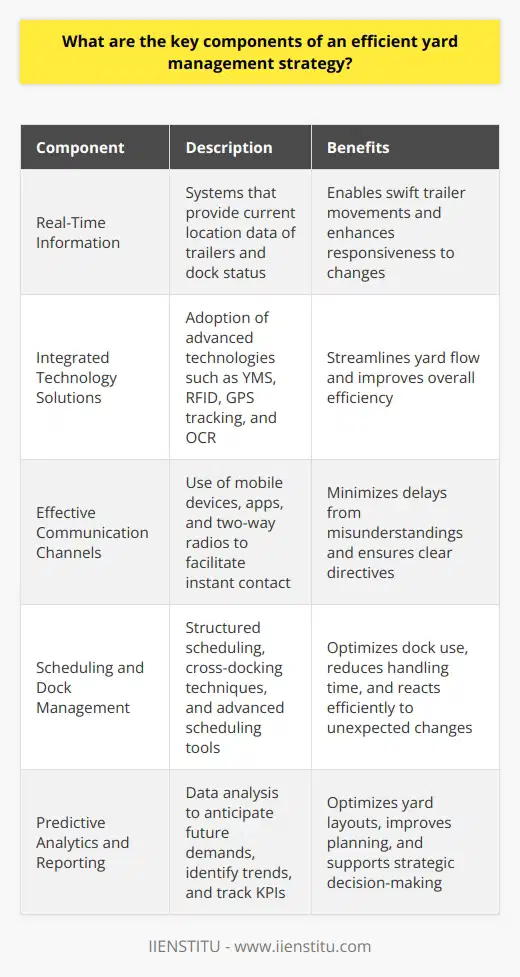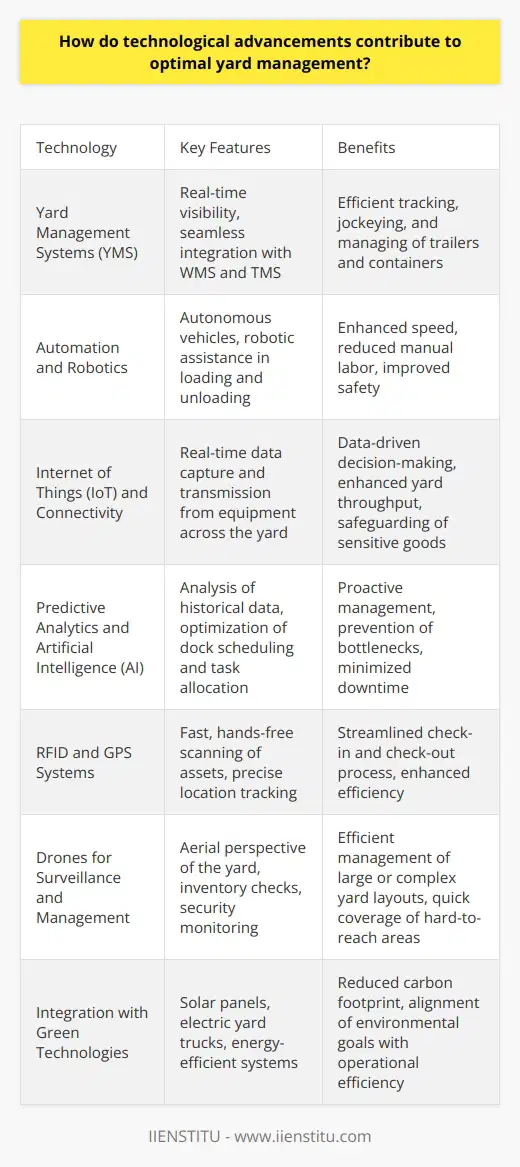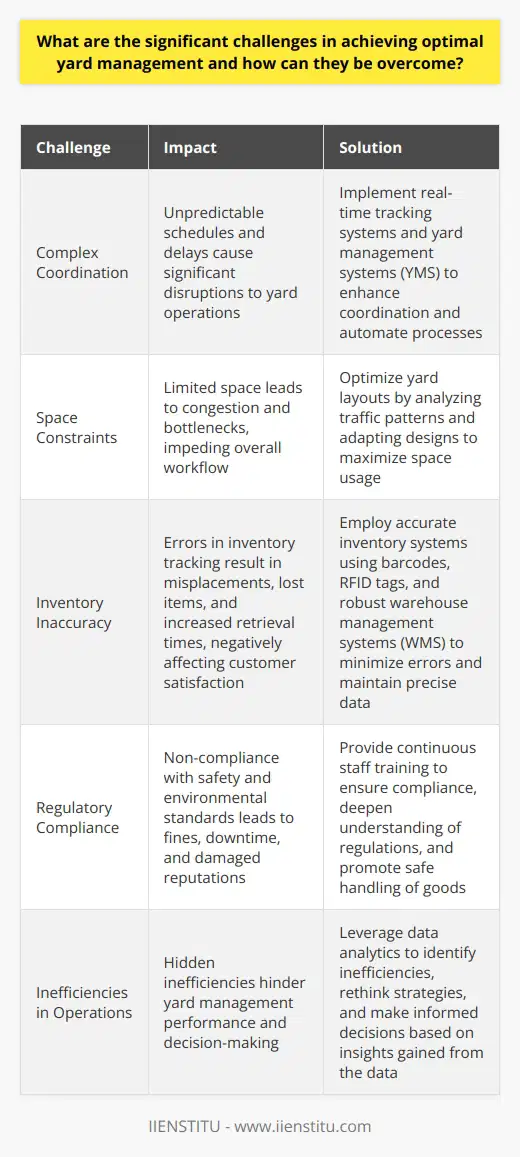
In the complex concert of modern logistics and supply chain operations, yard management emerges as a pivotal orchestrator of efficiency and productivity. This relatively subdued aspect of logistics, critical yet often underestimated, is what ensures the seamless transition of goods within distribution centers and warehouses.
By adopting effective yard management strategies, businesses can achieve a substantial enhancement in operational workflow, a reduction in turnaround times, and an overall elevation in service quality. The importance of yard management cannot be overstated; it is the silent force that ensures that the logistics dance is performed with grace and precision.
This scholarly review dives into the efficacious strategies that refine this art of movement coordination, pulling from the latest industry insights and enriched with practical examples.
Understanding Yard Management
Definition and Purpose of Yard Management
Yard management, at its core, is the administrative control of the yard space utilized by logistics companies for the handling of vehicles and trailers. It embodies all processes from the scheduling of transport movements to the allocation of docks and the prioritization of loading and unloading activities. The very purpose of yard management is to streamline these processes in such a way that it maximizes efficiency and minimizes downtime.
The Role of Yard Management in Logistics and Supply Chain
Within the broader spectrum of logistics and supply chain management, yard management plays a crucial role. It acts as the connective tissue between transportation and warehouse management, serving as a juncture where coordination and communication are key. When effectively managed, the yard can swiftly become a place of strategic advantage rather than a bottleneck, influencing the entire supply chain flow.
Types and Components of Yard Management Systems
Yard Management Systems (YMS) can vary significantly in sophistication, from simple manual systems to complex software that integrates with Warehouse Management Systems (WMS) and Transportation Management Systems (TMS). The fundamental components include yard check-in and check-out, dock door scheduling, yard jockeying, and real-time visibility into equipment and labor resources.
How Yard Management Affects Business Operations
The implementation of a well-structured YMS directly affects a plethora of business operations. It not only reduces delays associated with loading and unloading but also amplifies visibility and forecasting of inbound and outbound shipments. This visibility enables businesses to better allocate resources, reduce detention charges, and ultimately raise the standards of punctuality and reliability in their service delivery.
The Advantages of Effective Yard Management
Cost Reduction Benefits
An effective yard management strategy is instrumental in discovering cost-saving opportunities. By minimizing unnecessary jockeying, wait times, and manual check-in procedures, businesses can significantly cut labor and operational costs. Moreover, optimizing space and resources translates to reduced demurrage and detention fees, a common and costly hindrance in yard operations.
Improved Operational Efficiency
Efficiency in the yard equates to quicker turnaround times, higher throughput, and the alleviation of congestions often faced in logistics operations. Automated YMS solutions facilitate just-in-time practices, ensuring that vehicle movements and dock usage are precisely timed and utilized to their highest potential.
Enhanced Safety and Security
A well-managed yard naturally promotes a safer working environment by reducing vehicle traffic and ensuring safer pedestrian areas. Detailed visibility into vehicle and trailer locations also supports security measures, preventing theft and unauthorized access which are paramount concerns in logistics management.
Improved Service Delivery
When the operational pace of a yard is elevated, the entire chain reaps the rewards. Superior yard management leads to more accurate and timely order fulfillment, boosting customer satisfaction. The business is seen as reliable and capable, further strengthening its reputation within the supply chain network.
Case Study of Effective Yard Management
Brief Overview of a Company with an Efficient Yard Management Strategy
A textbook case of effective yard management is found in a global online retailer, which integrated state-of-the-art YMS into its vast network of fulfillment centers. The company's yard operations provide a shining example of logistical excellence, showcasing impressive improvements in speed, accuracy, and accountability.
Discussion on How the Company Implemented Its Yard Management System
The company initiated its transition by carefully identifying its specific yard needs and selecting a YMS that was both scalable and replete with the necessary functionalities. Comprehensive staff training and a phased implementation approach ensured minimal disruption, followed by consistent optimization and adjustments based on data analytics.
Analysis of the Benefits the Company Accrued from the System
Implementing the YMS yielded significant benefits for the retailer, including a reduction in trailer idling times by 30%, and a 25% decrease in fuel costs owing to less jockeying. Real-time data analytics enabled proactive responses to bottlenecks, and predictive scheduling optimized dock usage. Due to the enhanced efficiency, the company experienced improved relations with carriers and customers alike, contributing to an assertive competitive advantage.
Implementing a Yard Management System
Factors to Consider When Choosing a Yard Management System
Selecting the right YMS requires a considered understanding of various factors such as scalability, integration capabilities with existing systems, and the complexity of freight handling needs. The system should align with the business's strategic objectives and be flexible enough to adapt to the fluctuating demands of the logistics environment.
Steps to Implement the System
Once a suitable system is selected, meticulous planning is key to a successful implementation. Steps include developing a comprehensive project plan, involving all stakeholders, and ensuring that infrastructure and hardware requirements are in place. Rigorous testing must precede a full-scale rollout to identify and resolve any potential issues.
Potential Challenges and How to Address Them
Challenges that may arise include resistance to change from staff, technical glitches, or data integration obstacles. Addressing these challenges demands clear communication strategies, continuous training, and support, alongside the swift resolution of technical issues by the YMS provider. Emphasizing the long-term benefits and involving staff in the transition process can foster better acceptance and facilitate smoother adoption.
The Future of Yard Management
The Role of Technology in Yard Management
Technology is indisputably reshaping the landscape of yard management. Emerging solutions such as Artificial Intelligence (AI), drone technology, and the Internet of Things (IoT) are poised to enhance the precision and responsiveness of yard operations even further.
Emerging Innovations and Trends in Yard Management
Innovations like autonomous yard vehicles, predictive analytics, and advanced sensor technologies are set to revolutionize how yards operate. Utilizing these advancements will empower businesses to anticipate and manage their yard activities with a sophistication and agility previously unattainable.
How Businesses Can Prepare for These Changes
To prepare for these technological leaps, businesses should foster a culture of innovation and continuous improvement. Investing in employee skills development, staying abreast of industry trends, and building adaptable infrastructure are strategic moves that will enable businesses to harness the potential of tomorrow's yard management solutions.
The strategic importance of yard management in the efficiency and cost-effectiveness of logistics cannot be overstated. From reducing operational expenses to enhancing customer satisfaction, the advantages of effective yard management ripple throughout the logistical chain.
This review has underscored the significance of implementing thoughtful, technology-driven yard management strategies and offered insights into handling future trends and innovations. By weaving these strategies into their operational fabric, businesses are well-positioned to enjoy sustained growth, agility, and competitive edge in the intricate ballet of logistics and supply chain management.
Frequently Asked Questions
What are the key components of an efficient yard management strategy?
Understanding Yard Management
Efficient yard management forms a vital part of logistics. It ensures seamless movement within the yard. This movement pertains to vehicles, trailers, and inventory. Yard efficiency improves overall supply chain performance. However, achieving an efficient strategy involves several components.
Visibility and Real-Time Information
Real-time data forms the core of dynamic yard operations. Systems must provide current location data of trailers. They also need to inform about dock status. Live updates allow better decision-making. This results in swift trailer movements. Real-time visibility enhances responsiveness to changes.
Integrated Technology Solutions
Adoption of advanced technology defines smart yards. Yard management systems (YMS) handle operations effectively. Radio-frequency identification (RFID) tracks assets automatically. GPS tracking provides vehicle locations. Equipping gates with OCR technology assists in fast processing. These technologies streamline yard flow.
Effective Communication Channels
Communication remains key to yard efficiency. It connects drivers, yard staff, and distribution centers. Use of mobile devices and apps is common. Two-way radios also facilitate instant contact. Reliable communication ensures directives are clear. It minimizes delays from misunderstandings.
Scheduling and Dock Management
Structured scheduling optimizes dock use. It avoids dock congestion. Cross-docking techniques speed up transfers. Flow-through logistics reduce handling time. Advanced scheduling tools predict peak times. They adjust staffing and resources accordingly. Dynamic scheduling reacts to unexpected changes and does so efficiently.
Process Standardization
Standardized processes bring consistency. They make training easier. They ensure safety and compliance adherence. Standard procedures guide staff actions. They aid in managing day-to-day activities. They provide a basis for measuring performance.
Continuous Improvement and Adaptability
Continuous improvement is necessary. It drives efficiency gains over time. Regular analysis of operations identifies bottlenecks. Adaptability ensures the yard can handle varying volumes. It also deals with emergent challenges effectively. Feedback loops are essential. They enable constant evolution of practices.
Collaboration with Partners
Collaboration with stakeholders solidifies yard operations. Engaging transportation partners helps synchronize activities. Shared objectives between shippers, carriers, and vendors are important. Good relationships lead to better coordination. They also create opportunities for joint problem-solving.
Training and Workforce Management
Competent staff drive efficiency. Ongoing training ensures staff know the latest procedures. Workforce management tools schedule staff optimally. They track worker performance. They help in forecasting labor needs. An informed and well-managed workforce performs tasks proficiently.
Predictive Analytics and Reporting
Data analysis anticipates future demands. It identifies trends. Predictive analytics optimize yard layouts and processes. Using historical data improves planning. Reporting mechanisms allow you to track KPIs. These insights support strategic decision-making.
Safety and Security Measures
Safety protocols protect personnel and assets. Secure measures deter theft. They ensure operations comply with legal requirements. Regular audits highlight areas for safety improvements. Security systems like cameras monitor the yard constantly.
Environmental Considerations
Sustainability measures assist in two ways. They safeguard the environment. They reduce operational costs. Energy-efficient lighting decreases expenses. Green initiatives often meet customer expectations as well.
In conclusion, an efficient yard management strategy is complex. Yet, essential. It integrates technology, standardizes processes, and stresses continuous improvement. Collaboration and safety also feature prominently. These key components, when effectively implemented, lead to a streamlined, proactive, and high-performing yard operation.

How do technological advancements contribute to optimal yard management?
Technological Advancements in Yard Management
Yard management stands as a critical element in logistics. It governs the movement and storage of trailers and containers in the yard surrounding a warehouse or distribution center. Efficient yard management can significantly reduce detention and demurrage fees, improve turnaround times, and heighten overall logistics efficiency. Recent technological advancements have dramatically contributed to optimizing this process.
Streamlining Operations with Yard Management Systems
Yard Management Systems (YMS) are at the heart of these technological improvements. These software solutions provide real-time visibility over yard assets. They allow managers to track, jockey, and manage trailers and containers efficiently. YMS also interfaces seamlessly with Warehouse Management Systems (WMS) and Transportation Management Systems (TMS). Together, these technologies form an integrated approach for optimizing logistics operations.
Automation and Robotics
Robotic advancements and automation have become game-changers. Autonomous vehicles navigate yards without human intervention. They move goods more efficiently and with less error. Robots also assist with loading and unloading, cutting down manual labor time. This shift not only enhances speed but also boosts safety in the yard.
IoT and Connectivity
Internet of Things (IoT) devices capture and transmit data from equipment across the yard. Sensors on containers and trailers ensure real-time tracking of inventory. They also monitor environmental conditions to safeguard sensitive goods. This connectivity fosters data-driven decision-making, enhancing yard throughput.
Predictive Analytics and AI
Artificial Intelligence (AI) takes YMS a step further. It analyzes historical data to predict future yard congestion. Machine learning algorithms optimize dock scheduling and yard task allocation. Such predictive analytics can foresee issues, allowing for proactive management. This foresight prevents bottlenecks and minimizes downtime in yard operations.
RFID and GPS Systems
Radio Frequency Identification (RFID) and Global Positioning Systems (GPS) also play crucial roles. RFID tags provide fast, hands-free scanning of assets. GPS devices offer precise locations of trailers and containers in the yard. These systems streamline the check-in and check-out process, further enhancing efficiency.
Drones for Surveillance and Management
Drones offer an aerial perspective of the yard. They facilitate inventory checks and monitor security. This bird's-eye view helps in managing large or complex yard layouts. Drones can quickly cover areas hard for ground vehicles or personnel to reach.
Enhancing Communication
Advancements in communication technology, especially mobile devices, keep all stakeholders connected. Managers, drivers, and dock workers stay informed in real time. Improved communication speeds up decision-making and response times. This leads to a more cohesive and responsive yard management practice.
Integration with Green Technologies
Technology also supports sustainability in yard management. Solar panels and electric yard trucks reduce the carbon footprint. Energy-efficient systems align environmental goals with operational efficiency. Green technologies thus ensure that advances in yard management also consider ecological impacts.
With each technological stride, yard management becomes more optimal. These advancements drive efficiency, safety, and sustainability. Innovation benefits not just individual companies, but the entire supply chain. It reflects a future where technology and logistics move forward hand in hand.

What are the significant challenges in achieving optimal yard management and how can they be overcome?
Challenges in Yard Management
Complex Coordination
Yard management demands intricate coordination. Multiple vehicles arrive and depart. Each vehicle requires prompt unloading and loading. Schedules can be unpredictable. Delays are common. These can cause significant disruptions.
Space Constraints
Space often limits yard efficiency. Yards must maximize usage. Smart space allocation is crucial. Without it, congestion and bottlenecks occur. These impede overall workflow.
Inventory Inaccuracy
Accurate inventory tracking is vital. Errors can lead to misplacements. Lost items disrupt operations. They also increase retrieval times. This affects customer satisfaction negatively.
Regulatory Compliance
Yards must observe numerous regulations. These include safety and environmental standards. Non-compliance results in fines and downtime. It also damages reputations.
Solutions to Yard Management Challenges
Implement Technology
Technology enhances coordination. Real-time tracking systems are essential. They provide live updates on vehicle locations. Yard management systems (YMS) automate processes. YMS improves scheduling and space usage.
Optimize Layouts
Careful design optimizes yard space. Analyze traffic patterns. Adapt layouts to fit these patterns. This reduces congestion. It also speeds up vehicle processing.
Improve Inventory Systems
Accurate inventory systems are key. Use barcodes and RFID tags. They track goods efficiently. Employ robust warehouse management systems (WMS). WMS technology minimizes errors. It keeps inventory data precise.
Continuous Training
Staff training ensures compliance. Regular training updates skills. It deepens understanding of regulations. Trained staff handle goods more safely. They also maintain compliance.
Leverage Data Analytics
Data analytics offer insights. They identify inefficiencies in operations. Use this data to rethink strategies. Make more informed decisions based on analytics.
Foster Communication
Clear communication channels are crucial. They prevent misunderstandings. They also coordinate movements better. Use mobile devices and apps. These facilitate timely interactions.
Optimal yard management remains challenging. Yet, with strategic solutions, these challenges lessen. Employ technology and data analytics. Prioritize efficient layout and inventory accuracy. Invest in staff training. Keep communication channels clear. These steps can significantly improve yard management. They enhance both efficiency and compliance within the logistics landscape.



